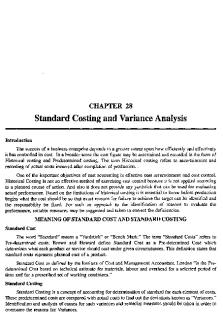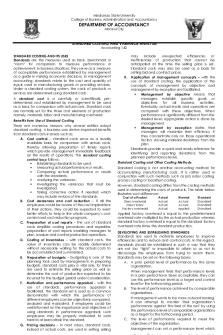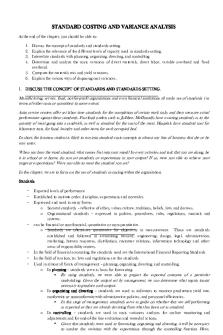Topic 3 Standard Costing PDF

| Title | Topic 3 Standard Costing |
|---|---|
| Course | Management Accounting |
| Institution | University of New South Wales |
| Pages | 4 |
| File Size | 197.2 KB |
| File Type | |
| Total Downloads | 89 |
| Total Views | 130 |
Summary
Topic 3 Standard Costing - tutorial questions week 3...
Description
UNSW Business School ACCT2522 Management Accounting 1 Term 1, 2021
Topic 3: Standard costing and variance analysis Week 3: Tutorial Questions Overall Theme The focus of this topic is on how standard costs and variance analysis are used to control costs. First, we learn how to set standard costs; and explore how different types of standards influence employee behavior. Second, we compute variances that compare actual against standard performance to identify discrepancies. Consistent with the “management by exception” approach, we finally investigate significant variances with an aim to understand the reasons underlying the variances in order to undertake corrective action and reduce cost. Desired Learning Outcomes and Essential Reading Required Reading Langfield-Smith, K., D. Smith, P. Andon, R. W. Hilton and H. Thorne (2018). Management Accounting: Information for Managing and Creating Value, 8th ed, McGraw-Hill Australia Pty Ltd. (Hereafter referred to as LS) Chapter 10 - Excluding journal entries (p. 498-499) Chapter 9 - Behavioural consequences of budgeting (p. 437 – 441)
1. 2. 3. 4. 5.
After completing this topic, you should be able to: Explain how standard costing can be used to control costs and manage resources effectively Understand the behavioural effects of standards Develop standard costs for direct material and direct labour Calculate Direct Material and Direct Labour variances Interpret and investigate variances
*Important Note* Before attempting your tutorial questions, please ensure that you have first completed your interactive pre-tutorial practice questions online as they provide guidance to answering your tutorial questions.
1
Tutorial Questions Part 1: Developing Standards (adapted from P10.38 Langfield-Smith) Fruit Freaks produces handmade frozen desserts for restaurants and hotels. Over the years, Fruit Freaks has built up a reputation of producing healthy frozen desserts that are made from good quality Australian ingredients. Florence Frost the CFO of Fruit Freaks noticed that standard costs have not been reviewed for the 2 years and is planning on conducting a review of its standard costing system. She has asked the production manager Winston Winters to collect production information on its more popular and established product, the Tropical Mango sherbet. The following information was collected. Tropical Mango sherbet is packed in 10 litre tubs. The following direct materials are normally required to produce one tub of sherbet: 10 kilograms of unbruised frozen mango pieces 3 kilograms of raw sugar 3 litres of coconut water 1 cardboard tub As a result of fruit imperfections, frozen mango pieces are sorted by hand to remove bruised mango pieces before production. Five minutes of direct labour is required to sort 1 kilogram of acceptable mango pieces. On average, 1 kilogram of mango pieces is discarded for every 8 kilograms of acceptable mango pieces. Acceptable frozen mango pieces are blended with raw sugar and coconut water to make the sherbet. It takes 15 minutes of direct labour time to blend the ingredients. After blending, the sherbet is packed in a cardboard tub and stored in the freezer room. It takes 3 minutes of direct labour time to pack and transport a box of sherbet to the freezer room. Ms Frost further collected the following costing information from the purchasing and human resource departments: Fruit Freaks purchases A grade frozen Australian mango pieces at a cost of $3 per kilogram. The cost of raw sugar is $0.07 per kilogram. The cost of coconut water is $2 per litre. One cardboard tub cost $0.15 each. Direct labour is paid at the rate of $27 per hour. Required: a) Calculate the standard cost of direct materials required to produce one tub of Tropical Mango sherbet. b) Calculate the standard cost of direct labour required to produce one tub of Tropical Mango sherbet. c) Calculate the standard cost of one tub of Tropical Mango sherbet. (Final answer = $70.71 per tub of sherbet) d) What other factors should Ms Frost’s management accountant take into consideration when setting direct material and direct labour standards? (Hint: You may wish to refer to your textbook or lecture slides for generic factors and tailor it to this case, where possible.)
4
Part 2: Variance Analysis As part of the standard costing review process, Ms Frost asked Mr Winters provide the latest monthly performance report which compares actual against budgeted figures. The following performance report for the month of February was provided:
No. of tubs of Tropical Man go sherbet Direct materials costs: Frozen mango pieces Raw sugar Coconut water Cardboard tubs Total direct material costs
Budget (a)
Actual (b)
Difference (a) – (b)
2,500
2,300
200
$
$
$
84,375.00 525.00 15,000.00 375.00 100,275.00
80,730.00 483.00 14,973.00 345.00 96,531.00
(3,645.00) (42.00) (27.00) (30.00) (3,744.00)
Direct labour costs
76,500.00
80,730.00
4,230.00
Total direct costs
176,775.00
177,261.00
486.00
Additional information: 2,990 direct labour hours were used to produce the 2,300 tubs of sherbets. To manage inventory storage costs, the purchasing department generally places monthly purchasing orders based approximately on next month’s budgeted production volume. The purchasing department paid $600.00 for 8,000 kilograms of raw sugar; $16,800 for 8,000 litres of coconut water, and $450.00 for 3,000 cardboard tubs. Four months ago, the purchasing manager took advantage of an opportunity to purchase 150,000 kilograms of frozen mangoes at discounted price of $405,000 from a frozen fruit manufacturer that went into receivership. Required: a) Ms Frost did not find the performance report very helpful, and asked Mr Winters to further: i) Calculate the direct materials variances for frozen mangoes, raw sugar, coconut water and cardboard tubs. ii) Calculate the direct labour variances. (Hint: All relevant standards required for calculating variances are developed in Part I of the question.)
b) Briefly explain the main reason why Ms Frost did not find the performance report very helpful. (Hint: Think about why the differences between budget and actual figures in the performance report arose.)
4
Part 3: Investigating Variances and setting standards Ms Frost held a meeting with Mr Winters, to discuss the variances and review the standard costs. The following comments were exchanged during the meeting: Mr Winters: I am very concerned about the recent performance of my department. I have noticed that the unfavourable DMQV for mangos and DLEV have been increasing over the last 3 months. This means that production workers are taking more time and using more mangoes to make the Tropical Mango sherbets. I think making allowances for poor quality mangoes in the standards sends the wrong message to employees. They now believe that it is ok to be inefficient. We should use perfection standards to send a message to employees that inefficiencies and wastage will not be tolerated! Ms Frost: Do you think using perfection standards is realistic? I think we need to consider how unrealistic perfection standards may affect production employees’ behaviour. Let’s properly investigate the root causes of these variances before deciding whether to use perfection or practical standards. Required: a) Do you agree with Winters’ comment that making allowances for mango wastage in the standards has caused employees to be inefficient, resulting in the unfavourable direct material quantity and direct labour efficiency variances? Based on case information, discuss the possible causes of the unfavourable direct material quantity variance for mangos and direct labour efficiency variance. Who do you think has control over these causes, and in your opinion who should be held responsible for these variances? b) Do you agree with Mr Winters’ comments regarding usage of perfection standards? How may unrealistic perfection standards affect employee’s behaviour? Explain your answer drawing on case information.
4...
Similar Free PDFs

Topic 3 Standard Costing
- 4 Pages

06 Standard Costing KEY
- 13 Pages

Standard Costing - Copy
- 16 Pages

Testbank Standard Costing
- 30 Pages

Objectives of Standard Costing
- 5 Pages
Popular Institutions
- Tinajero National High School - Annex
- Politeknik Caltex Riau
- Yokohama City University
- SGT University
- University of Al-Qadisiyah
- Divine Word College of Vigan
- Techniek College Rotterdam
- Universidade de Santiago
- Universiti Teknologi MARA Cawangan Johor Kampus Pasir Gudang
- Poltekkes Kemenkes Yogyakarta
- Baguio City National High School
- Colegio san marcos
- preparatoria uno
- Centro de Bachillerato Tecnológico Industrial y de Servicios No. 107
- Dalian Maritime University
- Quang Trung Secondary School
- Colegio Tecnológico en Informática
- Corporación Regional de Educación Superior
- Grupo CEDVA
- Dar Al Uloom University
- Centro de Estudios Preuniversitarios de la Universidad Nacional de Ingeniería
- 上智大学
- Aakash International School, Nuna Majara
- San Felipe Neri Catholic School
- Kang Chiao International School - New Taipei City
- Misamis Occidental National High School
- Institución Educativa Escuela Normal Juan Ladrilleros
- Kolehiyo ng Pantukan
- Batanes State College
- Instituto Continental
- Sekolah Menengah Kejuruan Kesehatan Kaltara (Tarakan)
- Colegio de La Inmaculada Concepcion - Cebu










